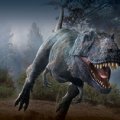Little Das' Hunt
Plot
North America, 75 million years ago is dominated by volcanoes, and out of the upland volcanic soil, plants grow and feed a herd of Orodromeus. Above them, a fleet of the 13-metre wingspan flying reptile,Quetzalcoatlus fly, on their way to the inland sea to hunt fish. Stalking the herd, is a pack of Troodon, and when the herd's century spots them, a chase begins. The Orodromeus run down a ledge and into a forset. With delicate toes, the Troodon walk down carefully and lose the herd. Suddenly, volcanic lava comes in contact with uderground water and geysers shoot out of the ground, killing one of the Troodon. Meanwhile, in the lowlands, a pair of young Maiasaura, a male named Buck and a female called Blaze walk away from the herd. They are surprised and chased down by a young Daspletosaurus called Little Das, who chases them into the clutches of his two older sisters, who then chase them to their mother. She bites Buck, but Little Das runs into her and both Buck and Blaze get away, Buck with a bite mark on his leg. The next day, the pack is tracking the Maiasaura herd down and their target is Buck. Little Das always messes up hunts, so the pack leave him behind while they close in. Little Das searches for them, only to find a herd of Einiosaurus, who run away from him into the Maiasaura herd and both herds run away. In the uplands, a herd of Orodromeus are drinking. A trio of Troodon suddenly comes to the sene. The herd hides. The Troodon smell them but run in the wrong direction away. Up on a mountain were hundreds of generations have lived, the fleet of Quetzalcoatlus roost. Suddenly, geysers strike the mountain and the fleet flee. Back in the lowlands, Little Das' pack stalk the Einiosaurus and Maiasaura herd. Blaze stays next to the injured Buck, right at the back of the herd. Little Das makes his move. The Maiasaura herd runs out into the open, but when the Einiosaurus herd form a blockade, Buck gets away and Little Das and his pack can't get through. Buck tries to get to the herd, with Blaze in front of him. Eventually, the Daspletosaurus pack begin to catch up to him. Suddenly, the volcano erupts and the packs of Troodon, herds of Orodromeus and fleets of Quetzalcoatlus from the uplands, are killed. Buck collapses and Little Das and his family retreat at the sight of the volcano and soon everything in the lowlands is killed. 7 million years later and there is a type of herbivore called Edmontosaurus, evolved from Maiasaura and twice as large. Stalking them, is the future evolution of Daspletosaurus. Tyrannosaurus rex.
Animals
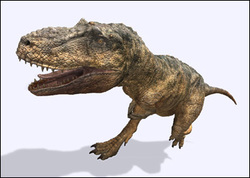
Daspletosaurus
These predators appear to be one of the closest relatives of the famous Tyrannosaurus. It has tiny arms with two fingers. And to balance that out, it has a huge head packed with sharp teeth and strong jaws. They measure about nine metres long and lived in North America, 75 million years ago.
These predators appear to be one of the closest relatives of the famous Tyrannosaurus. It has tiny arms with two fingers. And to balance that out, it has a huge head packed with sharp teeth and strong jaws. They measure about nine metres long and lived in North America, 75 million years ago.
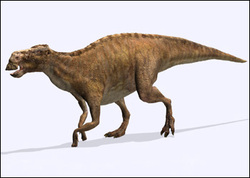
Maiasaura
These animals have a duck-like bill for eating plants and can walk on two or four legs. They live in huge colonies and breed together, where females would take care of their young. On average, they measure nine metres long and lived in North America, 75 million years ago.
These animals have a duck-like bill for eating plants and can walk on two or four legs. They live in huge colonies and breed together, where females would take care of their young. On average, they measure nine metres long and lived in North America, 75 million years ago.
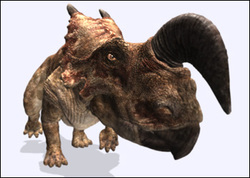
Einiosaurus
These herbivores look some what like Triceratops, with the beak, the frill, the body and the horns. But these horns are alot different to Triceratops. They are shaped like a hook. Not a good defence, but a nice display. Einiosaurus was six metres long and lived in North America, 75 million years ago.
These herbivores look some what like Triceratops, with the beak, the frill, the body and the horns. But these horns are alot different to Triceratops. They are shaped like a hook. Not a good defence, but a nice display. Einiosaurus was six metres long and lived in North America, 75 million years ago.
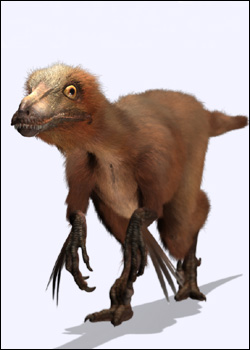
Troodon
These predators are the most intellegent of all dinosaurs, and are good at night hunting because of their huge eyes. In North America, they are two metres long. Males are dark brown, females light. On Hateg island, they are blue and measure one metre. They lived 80-75 million years ago.
These predators are the most intellegent of all dinosaurs, and are good at night hunting because of their huge eyes. In North America, they are two metres long. Males are dark brown, females light. On Hateg island, they are blue and measure one metre. They lived 80-75 million years ago.
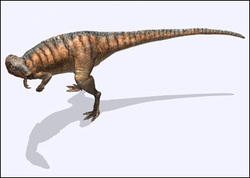
Orodromeus
These tiny little herbivores seem to have no defence. But they do: Eyes and legs. They use their huge eyes to look out for predators and when they spot one, they run for their lives. They are about a metre long and lived in North America, 75 million years ago.
These tiny little herbivores seem to have no defence. But they do: Eyes and legs. They use their huge eyes to look out for predators and when they spot one, they run for their lives. They are about a metre long and lived in North America, 75 million years ago.
